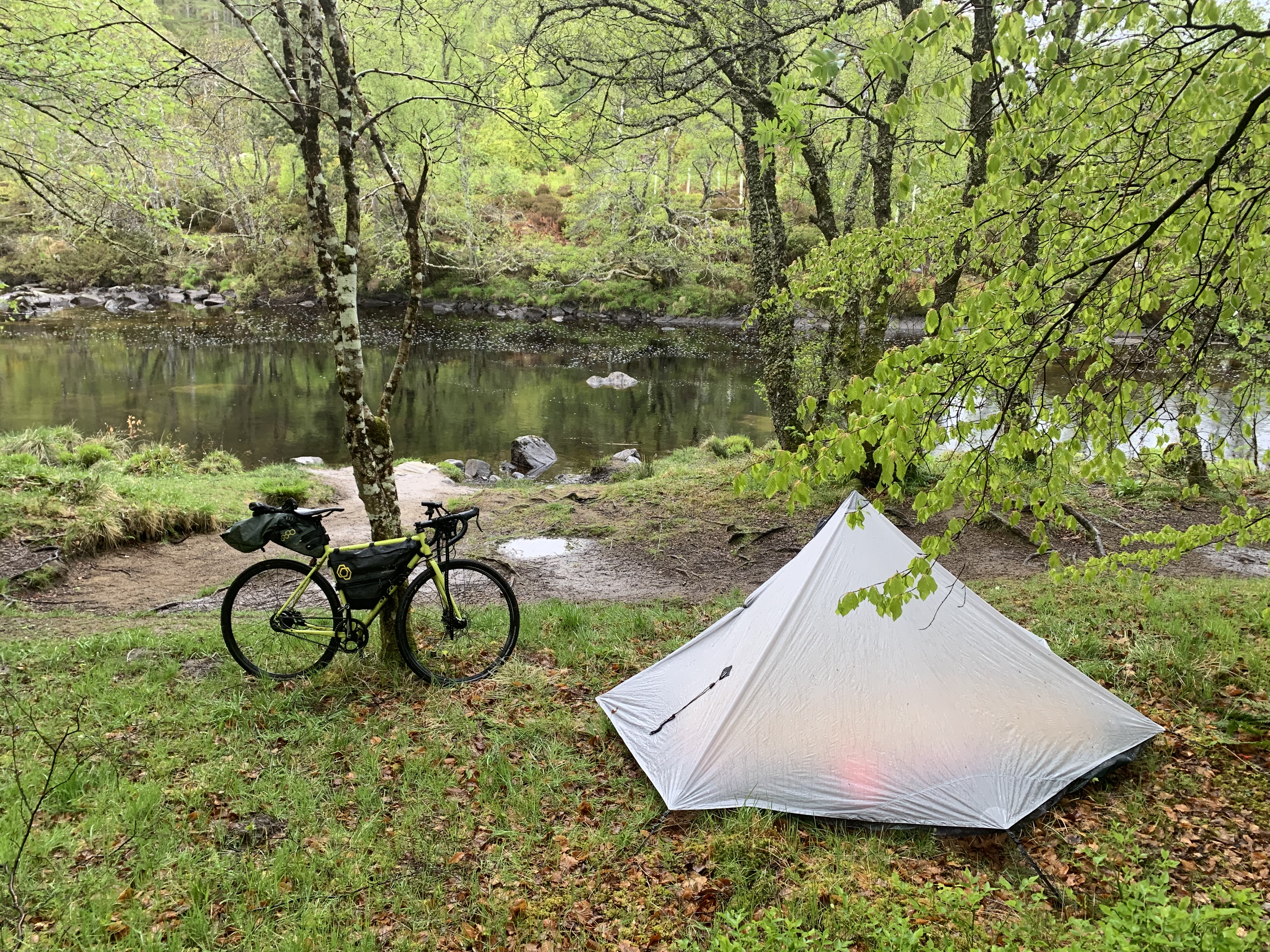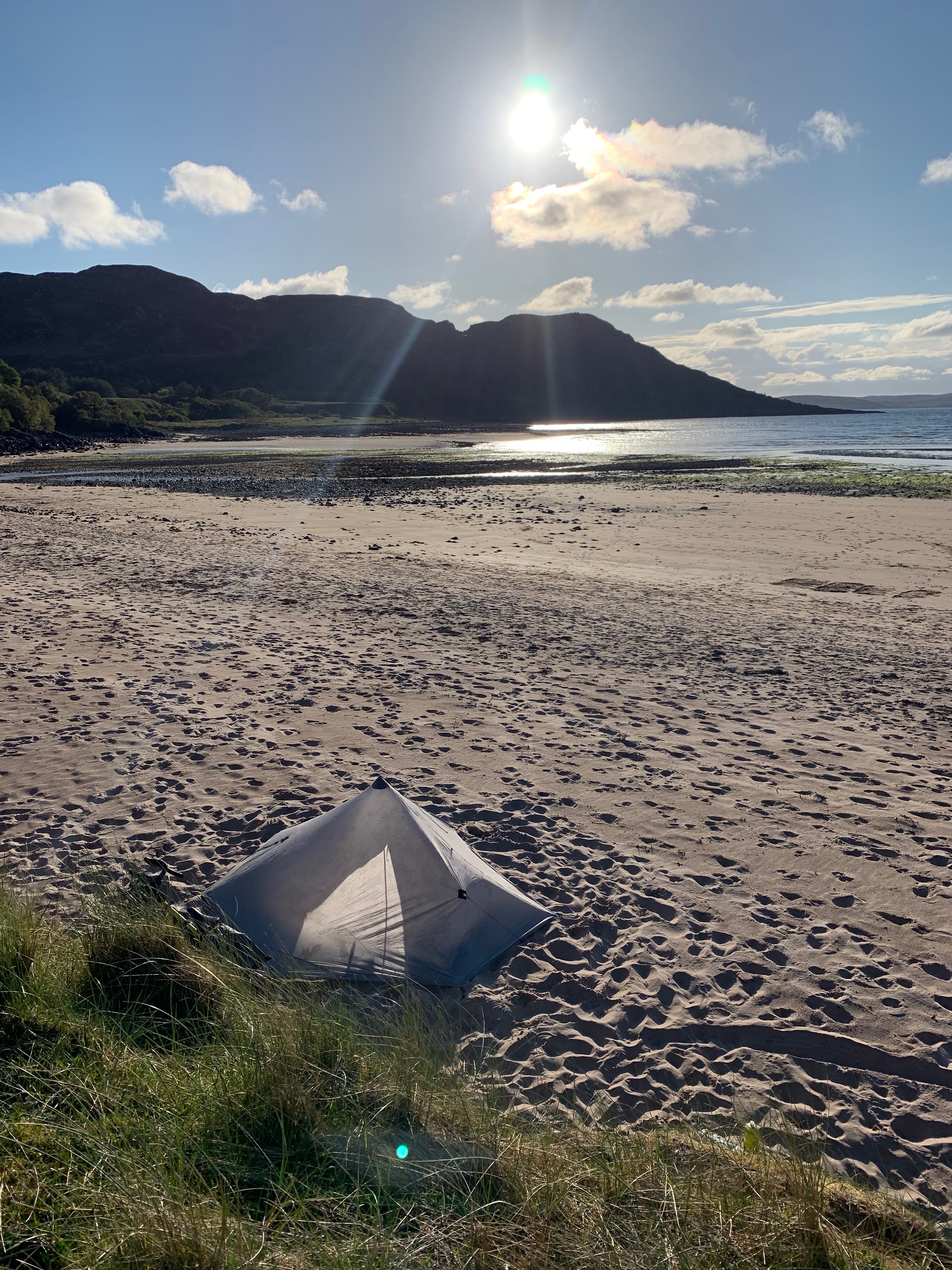
I’ve had several questions about this tarptent – so here’s a review of what I think of it. When I researched before buying this I couldn’t find a lot of useful info, so hopefully some of this will be of interest if you’re considering this shelter.
It’s a single skin, ultralight, tent shaped tarp with some excellent features. I tend to use this where I need minimal but reliable shelter and I’m not expecting to be in exposed or windy conditions. It packs down really small and all up weighs only 665 gms. This for me was one of the biggest benefits. If you want to go lighter there may be a few options available, but I think you’d be in Cuben/Dyneema fabric territory, which are usually fiendishly expensive, aren’;t they? The Deschutes Plus is currently available for $185, plus pole and pegs/stakes.
The 665g total weight breaks down as: Fly 495g inc stuffsack, carbon pole 51g, pegs 119g inc stuffsack. I’ve not made any special effort to use lighter pegs, though I did buy the carbon pole which saved 39 gms… I added 2 guys to the attachment points provided so the weight includes this along with the pegs needed. Full details below…
Here’s the link to Six Moon Designs – so read up here for what they are saying about their product: https://www.sixmoondesigns.com/collections/tarps/products/deschutes-plus



Pros:
Packs down very small. Good floor space. Reasonable sitting height. Well made. Mesh skirt to provide some insect protection. High spec fabrics will continue to be durable and weatherproof. Quick set-up. Really neat, minimal and pleasingly functional.
Cons:
Set up has quirks. Condensation (I live in the UK: humidity can be high). Not designed for a tight-as-a-drum pitch so flaps even in light wind. I wouldn’t use at all in high winds or exposed sites.
Review:
I should say straightaway that I love this shelter. When thinking of purchase it seemed reasonably priced to me (I bought it direct from USA), it works very well for a lot of conditions and I really enjoy using it. If you’re looking for a superlight set-up this is definitely worth considering. So, let’s tackle the less favourable issues first:
It may well be user-error… but I struggled a bit at first to get this set up correctly. I think the reason for this is my preference for setting up (mountain) tents or tarps to be as tight as possible: rain then bounces off ’em and the wind goes round. With the Deschutes Plus this doesn’t seem to be that possible. After the first couple of pitches I realised you need to stake out the first few pegs with a lot of slack in the system, otherwise you’ll end up with the tarp too close to the ground, which obviously reduces all the internal space. To be fair it does hint at this in the enclosed instructions, but it wasn’t that clear to me.
So once I’d sussed this I realised it’s possible to set up with the tarptent basically “hovering” above the ground, with the gap below filled by the mesh skirt – more on this in a min. But the problem is then that you cannot cinch the shelter down as tight as I’m used to so that it doesn’t flap in breezes. The cinch adjusters on each peg position allow you to tighten it down, but the single pole then bends alarmingly and the canopy still has looser sections, whichever way I’ve tried it. So the result is a (generally workable) compromise.
Of course we know all single skin tents will suffer from condensation in some conditions. In the UK I generally get a lot of it. Perhaps I’m a heavy breather and pump out a lot of moisture vapour…! (I doubt it.) Wet sleeping bag, mind where you touch the tent, drips etc. To be quite honest… the first time I slept out in higher winds and driving rain I woke convinced the tent was leaking. There was a fine yet refreshing… spray of water on my face each time a buffet of wind hit the tent. In fact it was the wind driving the condensation off the inside of the canopy into a fine mist that successfully dampened everything in the tent.
The solution is to leave most of the door open overnight – assuming you’ve got it pitched correctly away from the prevailing wind. Or you could just live somewhere dryer… As mentioned above I usually have one side of the front closed and one open depending on wind conditions. One slightly strange detail is that you insert the base of the pole into a grommet on the mesh skirt to locate it. This works well, but there isn’t another grommet on the mesh on the other side of the main zip. I guess this doesn’t matter in practice, as the fully open pic above demonstrates. Talking of the main zip: there’s a knack to opening and closing it as it crosses from the relatively loose mesh inside to the tighter canopy itself. It’s a lightweight zip so I have to take care here to make sure I don’t bust it.
EDIT: Here’s a very helpful comment from another user responding to this review on Facebook: “If you can’t get the tarp pitched tightly you need to revisit how you’re doing it. Set all the guy lines to their max length, peg out the front two points either side of the door leaving plenty of slack. Peg out the back. Insert the pole and peg the front. At this point I adjust the two points to make the front snug and the rear to snug it up across. The pole should be vertical all round. Peg out the remaining two side points and the tarp should now nice and tight. The fabric will settle a little after an hour or so, I adjust by moving the pegs. The more you pull on the guy points for adjustment the shorter they become which lowers the fabric which means less air flow and more condensation. You can use some short sticks under the guy points to lift the tarp for better air flow.”
EDIT: He also comments: “(I have the Lunar Solo) which is identical but a tent not a tarp. The worst conditions I’ve used it was a night of very heavy rain, thunder, lightning and high winds at 11,000 feet in the Rockies. No problems at all.” Encouraging to hear.
The mesh “skirt” attached to the perimeter of the tent is pretty effective. Once you’ve got the pitch sussed the skirt should be under tension all around inside the tent, providing a reasonable level of protection against flying bugs (as long as the door is shut, of course). I put a lightweight groundsheet on top of this, anchored by various bits of luggage and gear in the corners. For sure, Scottish midges for example will get in anywhere and you’ll have company from any insects that were already living where you put down your groundsheet, but I think this feature is good and well-designed.
Interior floor space is good. As I commented in the layout pic above I find at 6′ tall it’s quite tight from head to toe once I’m on a fairly high volume mat. I use a down bag and over a typical night it’s hard to avoid either the hood or footbox getting damp from touching one of the end walls.
Height at the apex is fine. The main issue I’ve had is with the canopy blowing inwards in wind. On this issue I’d be reluctant to use this anywhere but a reasonably sheltered pitch. Although Six Moon Designs say the Deschutes Plus “sheds winds under the harshest storms” in my opinion this seems an over-claim. You’d be in a flapping maelstrom inside and I’d be constantly concerned about the (otherwise excellent and superlight) carbon pole simply snapping. Maybe I have that wrong about the pole, or maybe the heavier aluminium pole option is sturdier, but whatever I don’t see this as a storm-proof shelter.

The optional guy-out points also are not where I’d have positioned them. After a couple of flappy nights I pressed these into service, but they seem to have a different purpose to guys on the type of mountain tents I’ve been used to. These seem to be here mainly to achieve more volume inside the structure rather stabilise it against wind. It could be that my misgivings on this are unreasonable: as a tight mountain tent may not be a fair comparison. I’m comparing this to 3-season tents, bytheway. But there it is.
Details I really like include: the prussik knot and clip on the main, front guy. It’s a really quick and effective way to get the front of the tent taut. Generally the speed of pitching is great too: a few peg placements, insert the pole and clip it to the front guy and you have your shelter. I also really like the silver colour. Although not camouflaged for stealth camping it is really nice to live inside on gloomy evenings and early mornings, being pleasingly translucent.
Conclusion
I’m really glad I bought this. It’s a great improvement on a regular tarp for no real extra weight penalty. Six Moon Designs generally have a great reputation and if this isn’t quite your ideal shelter have a look at some of their other options, they do a wide range of tents and tarps. Disclosure: nobody paid me to say this! Happy bivvying.
Thanks for the description. I was curious about how well it would do in the rain and the article answered it. Thanks.
LikeLike